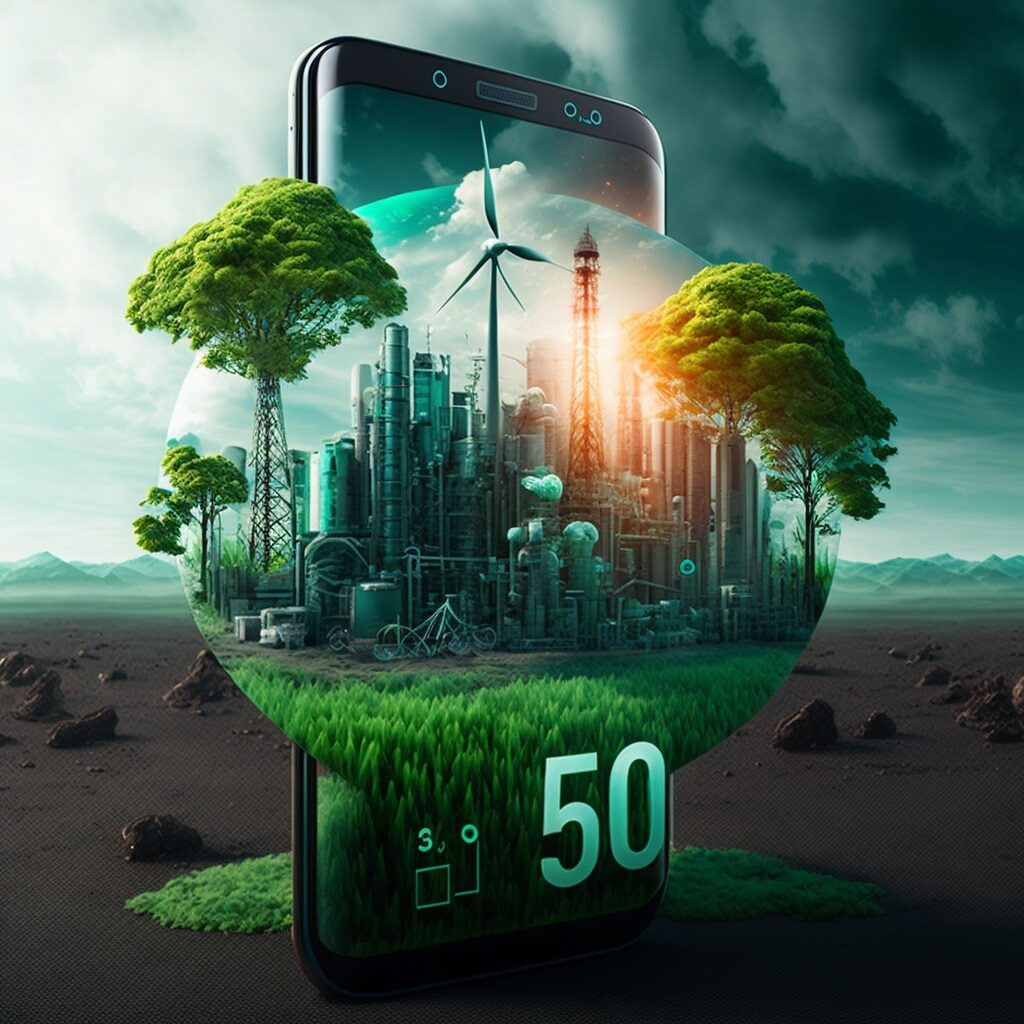How 5G Plays an Important Role in the Fight for Digital Sustainability
By Alexandra Emmert of cancel.io
Going green has become a buzzword in the last decade, and digitization is part of this. In today’s world, digital technology is playing a major role in how businesses reduce their waste and their carbon footprint. According to reports from the World Economic Forum, digital technology can reduce global emissions by 15%—and this number is set to increase as the adoption of digitization increases.
In the quest for ongoing and increasing sustainability, there are multiple avenues that businesses can explore that contribute to longevity and future successes. Environmental, social and governance (ESG) commitments are fast becoming mainstream requirements for ethical, socially conscious businesses. In turn, investors are using ESGs to measure sustainability and the ethical impact of potential investments. Digital sustainability has recently entered the equation too, with connectivity a core focus for the way forward.
Enter 5G.
5G is one of the few tools that offer great potential in these areas. Through the use of 5G (fifth generation mobile network), businesses can begin moving towards innovative, data-driven technologies and promote both environmental and digital sustainability.
The businesses that develop and implement better strategies for sustainability and eco-adjacency will keep up with the environmental, digital, and socio-economic fluctuations and thrive in the coming years. Those that don’t…well, the writing is on the wall.
If we learnt anything from the pandemic, it’s that digitization is an integral part of the future.
Keep reading to find out why 5G is a driving force in promoting digital sustainability in the business world and beyond.
5G Explained
5G is still a fairly new form of technology that gets met with confusion, a hefty dose of skepticism, criticism and controversy. From conspiracy theories to acts of arson, it’s clear that there’s a lot of misunderstanding about how this technology works.

In a nutshell, 5G is a global telecommunications network that enables peak-level connectivity between people, devices, machines, and other electronic objects.
The new and improved version of 1G, 2G, 3G, and 4G, 5G is the fifth generation of cellular networks. Up to 100 times faster than 4G, 5G is capable of delivering ultra-low latency, enormous network capacity, higher level multi-GBPS data speeds, and a more overall unified user experience. Essentially, it facilitates higher performance and efficiency, creating never-before-seen opportunities for people and industries.
5G’s groundbreaking data connectivity technology enables a massive variety of different technological processes, many of which can be harnessed to create a more sustainable, innovative, and prosperous world. But a major aspect of 5G is its impact on digital sustainability.
What Is Digital Sustainability?
Digital sustainability refers to the process of employing various environmental, economic, and social ministrations to digital services, products, and data.
Essentially, digital sustainability aims to use digital tools like 5G to empower communities, industries, and the global economy in a sustainable and environmentally friendly way. This makes 5G one of the most powerful tools of the modern age. If we can utilize it correctly.
One of the few downsides to 5G is that despite its massive potential for positive environmental change, it can generate considerable volumes of greenhouse gas while doing so. Therefore, to yield the best results, we will need to apply a forward-thinking and cautious approach to 5G implementation.
Digital Sustainability And Transformation
When implemented in a correct and eco-conscious manner, 5G has the potential to trigger immensely positive social, environmental, and digital change. Some might even say that it’s transformative.
But what does that mean on a practical level?
Let’s look at some tangible ways that 5G can stimulate digital and socio-economic evolution.
- Protection against cyberattacks
Cyberattacks are a very real threat capable of causing harm on multiple levels. Initially, the main concerns were legal or financial. IBM reports confirm this, and show that in 2022, the average cyber attack costs businesses with fewer than 500 employees $2.98 million. But increasingly, it’s not just bottom lines that are at risk. Human safety, and even lives, are at stake.
The number of cyberattacks within the first half of 2022 alone was up 42% from 2021, resulting in the loss of trillions of dollars annually. These figures are only expected to grow exponentially over time. Unless something about the way we approach data and connectivity changes.
This is where 5G comes in.
With its improved ability to authenticate and safeguard sensitive data, 5G virtual infrastructure is already being used to secure digital databases and avert cyberattacks. It’s a far more secure and robust alternative than previous generations and its resilient in the face of attack, as it can isolate network functions far more efficiently.

- Urban living and transportation
5G has the potential to dramatically change and improve the state of urban transportation, thus improving quality of life. There are many ways that this high-functioning data technology can support modern transportation methods, but there are three in particular worth noting:
- Introduction of MaaS (Mobility as a Service)
The concept of MaaS is to provide a public transport service that integrates on-demand and shared mobility services on a singular digital platform. Buses, metro and ferry services are available on the same online platform—generally an app—as ride-hailing, e-taxis and scooters, and rideshares. The aim is to streamline commuting and travel and reduce vehicles on the road, CO2 emissions, congestion and other traffic-related issues.
- Development of autonomous, interconnected vehicles
5G speeds up the development and release of autonomous vehicles, making them safer and more interconnected. Vehicle-2-Vehicle (V2V) communication is enhanced, as is communication between IoT-enabled road signals.
- Faster and more efficient travel logistics
5G connectivity makes road travel faster and more efficient, both on a passenger level and for the struggling logistics and transport industry. It increases safety, offers more sustainable travel alternatives, and overcomes multiple logistical challenges.
These innovations will mean that people get access to safer, more efficient transportation that is in alignment with cutting-edge sustainability models. It also means that supply chains are streamlined and that less waste and emissions occur.
- Intelligent agriculture
A functioning agriculture system is integral to human survival. But the systems we use today are vastly outdated and heavily reliant on human labor—an industry that is already fraught with exploitation, human rights violations, and environmentally unsustainable methods of farming.
However, 5G could change that for the better. The technology can be used to develop and utilize autonomous agriculture machinery and processes that rely considerably less on manual labor.
The implementation of 5G in farming could catalyze a turning point in the history of modern agriculture. With smart farming techniques and data-driven methods, we could yield better food crop production that utilizes fewer resources, improves waste management, and generally increase productivity. This would benefit every agricultural sector, however, it would have an even greater impact on farming in poorer countries where a single failed crop can lead to a famine.
- Clean energy
Clean, renewable energy is vitally important for the future of our planet, and the organizations that strive to create it could use all the help they can get. By aligning with efficient telecommunications technology like 5G, it will be easier to initiate and manage the renewable energy industry.
In conjunction with reducing the cost, merging 5G networks with clean energy reduces our dependency on fossil fuels, thus reducing the industry’s carbon footprint. It can also support the energy industry by providing remote power stations with better bandwidth and less data latency.

The Socio-Economic Benefits Of 5G
Evidently, there are many crucial advantages to the development and implementation of 5G networking technology. The intelligent connectivity that 5G enables and the digitization it promotes is a catalyst for socio-economic growth in what’s been termed the Fourth Industrial Revolution. As social and economic pillars make up two of the Three Pillars of Sustainability, it’s easy to see how important 5G is here.
We only have to look at our mobile phones to realize how many socio-economic benefits we have access to on a day-to-day basis. It’s never been easier to connect with others, shop online, access cost-effective digital services, and complete daily tasks remotely.
Pew Research confirms this. A study undertaken shows that the majority of 11 countries surveyed agree that mobile phones are good for society. With 5G, these benefits increase dramatically, especially for those in more rural, isolated, or underdeveloped areas.
By harnessing 5G’s high-speed connectivity qualities, humanity benefits in a variety of ways.
- Countering the effects of climate change
- Reaching environmental, social, and economic goals
- Improving the quality of life
- Enhanced food security
- Increased employment opportunities
- Protection against cyberwarfare and attacks
- Taking actionable steps towards a better future
Ultimately, 5G provides us with the tools we need to streamline technological systems and create a better model for human life. It also enhances digital sustainability and opens the door to new ways of reducing environmental impact. With a tool like this, many of the challenges we collectively face today can be either improved or completely eliminated.
In Conclusion
Like all technology, 5G is not a perfect tool. The internet and data processing still generate roughly 3.7% of greenhouse gasses. Therefore, it needs careful handling to create a positive impact on the environment and our various socio-economic systems.
However, there’s a lot more right with 5G than there is wrong with it. When used sensibly, it could be the key that unlocks better living conditions for people around the globe, a more sustainable global economy, and a much longer lease on life for planet Earth.